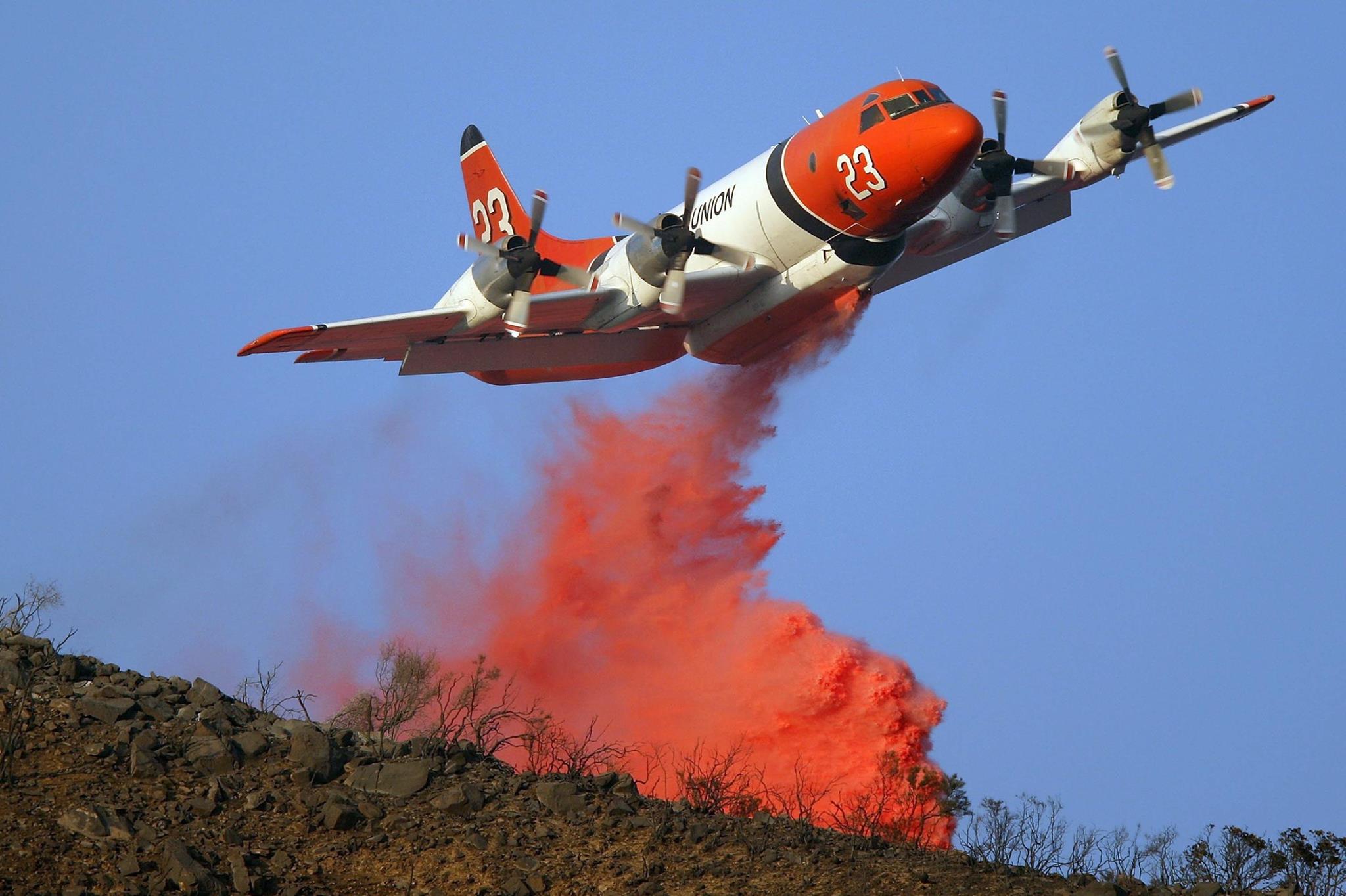Deviation Actions
Description
Pictured above is a Lockeed P-3A Aerostar (retrofitted ex military civilian P-3 Variant). The Aero Union P-3's have the most advanced fire retardant delivery system ever developed for an aerial fire fighting aircraft. The P-3 is capable of hauling 3,000 U.S. gallons of fire retardant. Aero Union operated this air frame along with 7 other P-3's until 2010. Photo taker unknown.
The Lockheed P-3 Orion is a four-engine turboprop anti-submarine and maritime surveillance aircraft developed for the United States Navy and introduced in the 1960s. Lockheed based it on the L-188 Electracommercial airliner. The aircraft is easily distinguished from the Electra by its distinctive tail stinger or "MAD Boom", used for the magnetic detection of submarines.
Over the years, the aircraft has seen numerous design advancements, most notably to its electronics packages. The P-3 Orion is still in use by numerous navies and air forces around the world, primarily formaritime patrol, reconnaissance, anti-surface warfare and anti-submarine warfare. A total of 734 P-3s have been built, and in 2012, it joined the handful of military aircraft including the Boeing B-52 Stratofortress,Boeing KC-135 Stratotanker and C-130 Hercules that have served 50 years of continuous use by the United States military. The U.S. Navy's remaining P-3C aircraft will eventually be replaced by the P-8A Poseidon.
The P-3 has an internal bomb bay under the front fuselage which can house conventional Mark 50 torpedoes or Mark 46 torpedoes and/or special (nuclear) weapons. Additional underwing stations, or pylons, can carry other armament configurations including the AGM-84 Harpoon, AGM-84E SLAM, AGM-84H/K SLAM-ER, the AGM-65 Maverick, 127 millimetres (5.0 in) Zuni rockets, and various other sea mines, missiles, and gravity bombs. The aircraft also had the capability to carry the AGM-12 Bullpup guided missile until that weapon was withdrawn from U.S./NATO/Allied service.
The P-3 is equipped with a magnetic anomaly detector (MAD) in the extended tail. This instrument is able to detect the magnetic anomaly of a submarine in the Earth's magnetic field. The limited range of this instrument requires the aircraft to be near the submarine at low altitude. Because of this, it is primarily used for pinpointing the location of a submarine immediately prior to a torpedo or depth bomb attack. Due to the sensitivity of the detector, electromagnetic noise can interfere with it, so the detector is placed in P-3's fiberglass tail stinger (MAD boom), far from other electronics and ferrous metals on the aircraft.
Role: Maritime patrol aircraft
National origin: United States
Manufacturer: Lockheed, Lockheed Martin, Kawasaki Heavy Industries
First flight: November 1959
Introduction: August 1962
Status: Active
Primary users: United States Navy,Japan Maritime Self-Defense Force,Royal Australian Air Force,Republic of Korea Navy
Produced: 1961–1990
Number built: Lockheed – 650, Kawasaki – 107, Total – 757
Unit cost: US$36 million (FY1987)
Developed from: Lockheed L-188 Electra
Variants: Lockheed AP-3C Orion,Lockheed CP-140 Aurora,Lockheed EP-3,Lockheed WP-3D Orion
Developed into: Lockheed P-7
General characteristics
- Crew: 11
- Length: 116 ft 10 in (35.6 m)
- Wingspan: 99 ft 8 in (30.4 m)
- Height: 38 ft 8 in (11.8 m)</i>
- Wing area: 1300 ft² (120.8 m²)
- Airfoil: NACA 0014-1.10 (Root) – NACA 0012-1.10 (Tip)</i>
- Empty weight: 77,200 lb (35,000 kg)
- Loaded weight: 135,000 lb (61,400 kg)
- Useful load: 57,800 lb (26,400 kg)
- Max. takeoff weight: 142,000 lb (64,400 kg)
- Powerplant: 4 × Allison T56-A-14 turboprop, 4,600 shp (3,700 kW) each</i>
- Propellers: Four-bladed Hamilton Standard propeller, 1 per engine
- Propeller diameter: 13 ft 6 in (4.11 m)
Performance
- Maximum speed: 411 kn (750 km/h)
- Cruise speed: 328 kn (610 km/h)
- Range: 2,380 nmi radius (4,400 km)
- Combat radius: 1,346 nmi (2,490 km) three hours on-station at 1,500 feet
- Ferry range: 4,830 nmi (8,944 km)
- Endurance: 16 hours
- Service ceiling: 28,300 ft (8,625 m)
- Rate of climb: 3,140 ft/min (16 m/s)
- Wing loading: 107 lb/ft² (530 kg/m²)
- Power/mass: 0.136 hp/lb at max gross (0.23 kW/kg)
Armament
- Guns: None
- Hardpoints: 10 wing stations in total (3x on each wing and 2x on each wing root) and eight internal bomb bay stations with a capacity of 20,000 lb (9,100 kg) and provisions to carry combinations of:
- Rockets: None
- Missiles:
- Bombs:
- Depth charges, Mk 101 Lulu nuclear depth bomb, MK20 Rockeye, MK80 Series (MK82, MK83, MK84) general purpose bombs, B57 nuclear bomb (US service only, retired 1993)
- Other:
- Mk 44 (mostly retired from service), Mk 46, Mk 50, Mk 54 or MU90 Impact torpedoes
- Mk 25, Mk 39, Mk 55, Mk 56, Mk 60 CAPTOR or Mk 65 Quickstrike naval mines
- Stonefish naval mine (in Australian service)
- Active and passive Sonobuoys
Avionics
- RADAR: Raytheon AN/APS-115 Maritime Surveillance Radar, AN/APS-137D(V)5 Inverse Synthetic Aperture Search Radar
- IFF: APX-72, APX-76, APX-118/123 Interrogation Friend or Foe (IFF)
- EO/IR: ASX-4 Advanced Imaging Multispectral Sensor (AIMS), ASX-6 Multi-Mode Imaging System (MMIS)
- ESM: ALR-66 Radar Warning Receiver, ALR-95(V)2 Specific Emitter Identification/Threat Warning
- Hazeltine Corporation AN/ARR-78(V) sonobuoy receiving system
- Fighting Electronics Inc AN/ARR-72 sonobuoy receiver
- IBM Proteus UYS-1 acoustic processor
- AQA-7 directional acoustic frequency analysis and recording sonobuoy indicators
- AQH-4 (V) sonar tape recorder
- ASQ-81 magnetic anomaly detector (MAD)
- ASA-65 magnetic compensator
- Lockheed Martin AN/ALQ-78(V) electronic surveillance receiver
:origin()/pre00/7bc9/th/pre/f/2016/093/3/a/lockheed_p_3_orion_by_generaltate-d9xio89.jpg)
:origin()/pre00/a75e/th/pre/f/2017/140/f/e/lockheed_wp_3d_orion_noaa_hurricane_hunter_by_generaltate-db9sqhn.jpg)
:origin()/pre00/8cce/th/pre/f/2018/114/4/5/lockheed_p_3a_aerostar__aero_union__n925au_by_generaltate-dc9qr36.jpg)
National Geographic- Fire Bombers 1998
Be sure to follow me on Dailymotion!




































